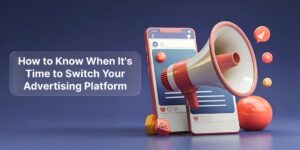
When ‘Always-On’ Doesn’t Always Work
The idea behind always-on campaigns sounds smart: consistent visibility, ongoing traffic, a steady flow of leads. But what happens when those campaigns start blending into the background? No engagement spikes, no clear performance trends just a stream of disjointed impressions and clicks that don’t add up to pipeline movement.
It’s a common problem. The campaign is always on… but the impact feels like it’s always off.
This isn’t a media budget issue. It’s a structure issue. And more often than not, the fix isn’t more spending, it’s better orchestration.
Disjointed Campaigns Create Fragmented Journeys

Let’s say you’re running a mix of brand, lead gen, and retargeting campaigns. You’ve got assets flying across formats, carousels, videos, PDFs, and static posts. On the surface, it looks like a healthy mix. But under the hood, things feel messy.
Are you guiding the same buyers from one touchpoint to the next? Are the messages layered or clashing? Does your audience feel like they’re on a journey or just seeing random ads on repeat?
When campaign structure lacks cohesion, buyers don’t know what to do next. And when there’s no momentum, leads drop off. Not because they aren’t interested but because the experience wasn’t built to help them progress.
Also Read: Effective Methods of Protecting Advertising Campaigns from Bots
The Cost of “Just Run It” Campaigns
Without a framework, always-on becomes always-reactive. Teams end up chasing short-term fixes: tweaking copy here, adjusting bids there, launching one-off creative to hit arbitrary MQL goals. It’s exhausting. And it rarely compounds into anything meaningful.
More critically, these ad-hoc campaigns often fail to build memory structures, those small, repeatable signals that help buyers recall your brand when they’re actually ready to make a decision. Awareness is easy to buy. Preference is built.
This is where structured strategy outperforms tactical tinkering.
Also Read: How to Create Successful Email Marketing Campaigns: A Step-by-Step Guide
The Shift to Scalable Frameworks

High-growth SaaS companies that see long-term success with always-on LinkedIn campaigns aren’t doing it randomly. They’re operating on clear campaign frameworks that treat paid media like a growth system, not a slot machine.
These frameworks usually include:
1. Full-funnel sequencing:
Building a narrative that flows from pain awareness → category education → solution validation → customer proof → CTA.
2. Content orchestration:
Using the same campaign architecture across formats, and PDFs, videos, statics, to reinforce key messages without over-relying on any single format.
3. Audience choreography:
Mapping your buyers’ actual journey through CRM data, then aligning campaign stages to follow their behaviour rather than just targeting based on job titles.
4. Creative calendars:
Treating creative as a living system, refreshed intentionally every 4–6 weeks with updated hooks and formats while keeping the messaging consistent.
5. Post-click alignment:
Ensure your landing pages, sales follow-up, and lead scoring align with the campaign stage and intent, rather than sending every click to the same “Book a Demo” page.
How Agencies Help Keep Campaigns On Track
In-house teams are often stretched too thin to run this kind of structure end-to-end. That’s where partnering with focused Linkedin ad agencies can shift everything. For B2B companies focused on building pipeline, a LinkedIn lead gen agency can also help extend beyond ads—optimizing outreach, targeting, and message testing directly on the platform.
These agencies don’t just launch ads. They help you build out the strategy, audience logic, creative workflows, and reporting frameworks that let you scale intelligently. They’ve already seen what works (and what burns budget) across similar buying cycles and they help you avoid reinventing the wheel.
They also serve as a reality check: Are your campaigns laddering up to the outcomes that matter? Are you investing in moments that build a pipeline, or just chasing cheap leads that never convert?
The best agencies won’t let you chase noise. They’ll help you chase momentum.
Let the Campaigns Run—But with Direction
Always-on shouldn’t mean autopilot. It should mean your campaigns are strategically designed to compound to build brand recall, buying intent, and sales velocity over time.
And that doesn’t happen by chance.
When you bring structure to your always-on strategy, when your team knows which message belongs where, when, and why performance starts to stabilize. And then it grows.
So if your current always-on setup feels like it’s just running in circles, maybe it’s not the idea that’s broken. Maybe it just needs better architecture behind it.






